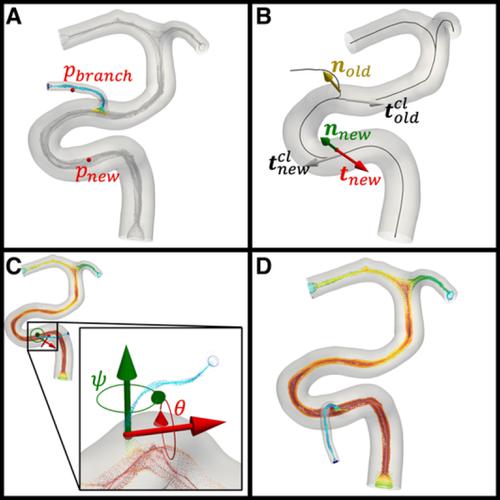当前位置:
X-MOL 学术
›
Int. J. Numer. Method. Biomed. Eng.
›
论文详情
Our official English website, www.x-mol.net, welcomes your feedback! (Note: you will need to create a separate account there.)
A framework for automated and objective modification of tubular structures: Application to the internal carotid artery.
International Journal for Numerical Methods in Biomedical Engineering ( IF 2.1 ) Pub Date : 2020-03-14 , DOI: 10.1002/cnm.3330 Aslak W Bergersen 1 , Henrik A Kjeldsberg 1 , Kristian Valen-Sendstad 1
International Journal for Numerical Methods in Biomedical Engineering ( IF 2.1 ) Pub Date : 2020-03-14 , DOI: 10.1002/cnm.3330 Aslak W Bergersen 1 , Henrik A Kjeldsberg 1 , Kristian Valen-Sendstad 1
Affiliation

|
Patient‐specific medical image‐based computational fluid dynamics has been widely used to reveal fundamental insight into mechanisms of cardiovascular disease, for instance, correlating morphology to adverse vascular remodeling. However, segmentation of medical images is laborious, error‐prone, and a bottleneck in the development of large databases that are needed to capture the natural variability in morphology. Instead, idealized models, where morphological features are parameterized, have been used to investigate the correlation with flow features, but at the cost of limited understanding of the complexity of cardiovascular flows. To combine the advantages of both approaches, we developed a tool that preserves the patient‐specificness inherent in medical images while allowing for parametric alteration of the morphology. In our open‐source framework morphMan we convert the segmented surface to a Voronoi diagram, modify the diagram to change the morphological features of interest, and then convert back to a new surface. In this paper, we present algorithms for modifying bifurcation angles, location of branches, cross‐sectional area, vessel curvature, shape of bends, and surface roughness. We show qualitative and quantitative validation of the algorithms, performing with an accuracy exceeding 97% in general, and proof‐of‐concept on combining the tool with computational fluid dynamics. By combining morphMan with appropriate clinical measurements, one could explore the morphological parameter space and resulting hemodynamic response using only a handful of segmented surfaces, effectively minimizing the main bottleneck in image‐based computational fluid dynamics.
中文翻译:

自动和客观地修改管状结构的框架:应用于颈内动脉。
基于患者特定医学图像的计算流体动力学已广泛用于揭示对心血管疾病机制的基本见解,例如,将形态学与不良血管重塑相关联。但是,医学图像的分割是费力的,容易出错的,并且是捕获形态上自然变化所需的大型数据库开发的瓶颈。取而代之的是,已使用理想化的模型(其中已对形态特征进行了参数化)来研究与血流特征的相关性,但代价是对心血管血流复杂性的了解有限。为了结合这两种方法的优点,我们开发了一种工具,该工具既可以保留医学图像固有的患者特异性,又可以对形态进行参数更改。morphMan我们将分割后的曲面转换为Voronoi图,修改该图以更改感兴趣的形态特征,然后转换回新的曲面。在本文中,我们提出了用于修改分叉角,分支位置,横截面积,血管曲率,弯曲形状和表面粗糙度的算法。我们展示了算法的定性和定量验证,其执行的准确性通常超过97%,并结合了该工具与计算流体动力学进行了概念验证。通过结合morphMan 通过适当的临床测量,可以仅使用少量的分割表面来探索形态学参数空间以及由此产生的血液动力学反应,从而有效地最小化基于图像的计算流体动力学中的主要瓶颈。
更新日期:2020-03-14
中文翻译:

自动和客观地修改管状结构的框架:应用于颈内动脉。
基于患者特定医学图像的计算流体动力学已广泛用于揭示对心血管疾病机制的基本见解,例如,将形态学与不良血管重塑相关联。但是,医学图像的分割是费力的,容易出错的,并且是捕获形态上自然变化所需的大型数据库开发的瓶颈。取而代之的是,已使用理想化的模型(其中已对形态特征进行了参数化)来研究与血流特征的相关性,但代价是对心血管血流复杂性的了解有限。为了结合这两种方法的优点,我们开发了一种工具,该工具既可以保留医学图像固有的患者特异性,又可以对形态进行参数更改。morphMan我们将分割后的曲面转换为Voronoi图,修改该图以更改感兴趣的形态特征,然后转换回新的曲面。在本文中,我们提出了用于修改分叉角,分支位置,横截面积,血管曲率,弯曲形状和表面粗糙度的算法。我们展示了算法的定性和定量验证,其执行的准确性通常超过97%,并结合了该工具与计算流体动力学进行了概念验证。通过结合morphMan 通过适当的临床测量,可以仅使用少量的分割表面来探索形态学参数空间以及由此产生的血液动力学反应,从而有效地最小化基于图像的计算流体动力学中的主要瓶颈。


























 京公网安备 11010802027423号
京公网安备 11010802027423号